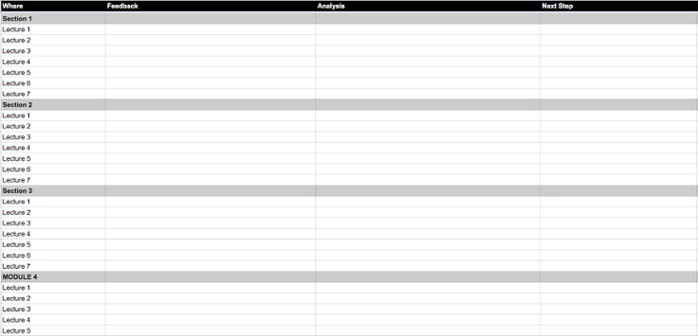Pre-selling your online course might just be as valuable to your course launch success as your course content itself. A successful pre-sale is the number one way to ensure you’re creating an online product that has an audience and is exactly what your audience wants and needs. Luckily, learning how to pre-sell your online course is easy.
Defining the pre-sale
A pre-sale is a targeted sale before your product actually goes live. You sell the idea of your course to a small portion of your audience before you’ve created all of your course content. Typically, you pre-sell by setting up your sales page, discounting your course, and sending an email out to your list (or communicating the sale to your audience in another way). This process gives you feedback to improve your course content, which can then allow you to charge more in the long run.
The question of why
You pre-sell so you can drip out your content and get feedback from a small batch of customers. You will use this feedback to adjust your game plan as you go and improve the quality of your course before you launch and begin promoting to your entire audience. It’s as simple as that.
Collecting feedback from a targeted audience who wants you to succeed is powerful. You can use that feedback to increase the value of your course and work out all of the kinks before you make your course available to the public.
Collecting feedback also allows you to move past the common “what ifs” fear that Pat Flynn mentioned in his book Will it Fly?.
“A lot of people have ideas, but they don’t want to execute because they’re not sure whether or not that thing that they are going to be working on is actually worth that time and effort. And those what ifs, which are initially, ‘What if this works’, ‘What if this is the one’, those end up turning into: ‘What if I fail’, ‘What if I let my family down’ and ‘What if it was all for nothing.’ And they don’t do anything—they are much more comfortable being complacent with where they are than potentially failing.”
A successful pre-sale of your online course will make you feel confident your course will make money. Pre-sales also allow you to create a course catered to your audience, work out any kinks, and ensure that you’re selling the best product that you possibly can.
Breaking it all down
Now that you have an idea of what a pre-sale is and why it’s a must for launching your online course, let’s dive into how to create a successful pre-sale for your online course.
Step 1: Observe and learn
It’s likely you already spend a lot of time in the same communities that your audience does, so now all you have to do is take note of the conversations and locate common pain points. When you know what your audience is struggling with, it’ll be easier to cater a course directly to them and ensure that you’re providing the most value possible.
Step 2: Dip your toes in the water
Just don’t build all of it. We recommend dripping your course out and creating content as you go as opposed to creating your entire course before launching any sort of sale.
Make around 20% of your course to begin with and make that portion available to your beta testers. Collect their early feedback before creating the rest of your course.
This is important for four reasons:
- You won’t waste time. If you decide you don’t want to continue creating that particular course, you can repurpose the 20% of content you did create and you won’t be at a loss.
- You get feedback as your audience consumes your course. After the first section goes live, your audience might say that they prefer your screenflows over live video, or that the sound quality was a little wonky. You can take this early feedback and implement it into the rest of your course, catering the content to what your audience prefers.
- You’ll be on a deadline. If you have a course full of eager students who are looking forward to weekly updates, you’ll be much more likely to prioritize content creation and won’t fall behind.
- You’ll be making money to improve your course. You may decide that you need to invest in a microphone or a better editing system to add value to your course. Now that you’ve made money pre-selling, you’ve got a cushion to do so.
Step 3: Show—and sell
Before you can start generating pre-sales, you want somewhere to send students. Creating a sales page on Teachable is intuitive, but here’s a quick peek of what your sales page on Teachable can look like:

Find more examples of more inspirational sales pages here. You can get creative with the design and formatting of your page, but you should consider adding these elements in addition to what we recommend in a standard sales page.
- Be explicit in saying that this is a pre-sale. Let your customers know that they will be beta students and content will be dripped out to them. Also mention when the course goes live and officially launches.
- Make the discount apparent. Write directly on the enroll button that your course is at a special presale price. Knowing that the price is going to increase will add a sense of urgency.
- Add a countdown timer. Utilizing a visual showing exactly how much time a customer has to buy before a price increase will make them more likely to take the plunge then and there.
- Add testimonials. If you can get testimonials about how informative you are and how high quality your other content is, you can use that until you get course testimonials.
- Don’t skip out on the author bio. Use this space to establish yourself as an authority and as a real person! People want to know who they’re buying from.
A successful pre-sale in action
We’ve seen first-time instructors have successful pre-sales and make five to six figures. For instance, Bree Noble runs The Female Musician Academy & Artist Collective where she helps women master the business of music. Her successful pre-sale strategy was simple, but it worked.
Bree pre-sold her course before she had created any content at all using only her sales page. She said, “…my new students told me that my Teachable school was so beautiful that they could tell the course was going to be amazing.”

Using her sales page alone, Bree pre-sold to 15 people at $290 each, making $4,350 off of her course before it even launched.
Step 4: Embrace your network
During a successful pre-sale, you don’t want to market to your entire audience. Rather, you’ll market to a select group of people in your network. At Teachable, we recommend sending your pre-sale offer to your email list.
Your email list is full of people who are already fans of yours, and you’ve already provided them with a lot of high-quality content. From there, you should send your list a single pre-sale email. This email should announce your course and let your audience know that they have the exclusive opportunity to be beta students.
What’s in a successful pre-sale email?
The key to marketing to your email list is to send only one email announcing your pre-launch. By sending only one email, you’re targeting your most engaged, loyal, perceptive subscribers. But it’s not enough to simply ask your audience to purchase. You want to be strategic and clearly communicate your expectations.
Get your audience excited about your content and about having the opportunity to directly influence your course through their feedback. Let’s break this down further:
- Remind your email list that this is an exclusive opportunity just for them.
- Include a strong “Call To Action” in your email. Don’t just hyperlink text — put in a button that your audience won’t be able to miss.
- Set expectations for your first students by:
- Requesting feedback by sending emails as the course progresses
- Asking for engagements in the comment section of your course
- Sending a survey at the end
- Providing live Q&A sessions or coaching sessions as additional value and opportunities for course feedback
Step 5: Make sense of it all
Collecting feedback and taking action is the best way you can increase the value of your course and cater it to your audience. There are three different ways for you to collect feedback:
- Aggregate your feedback: Compile feedback from within the course and any accompanying communities you’ve created. Make special notes of questions that pop up more than once.
- Email your most engaged students: Ask for these students’ input on what they liked and what you should adjust.
- Send a survey. Send a general survey (Google Form is a great way to start) to your entire audience to collect more feedback.
A few general questions you may want to ask are:
- What parts of the course (if any) were vague? Where were you confused?
- What wasn’t taught in the course that should have been?
- What do you want to see more of?
- How was the quality?
Stress to your students that you will use their feedback to make the course even better. And remind them that as your beta testers, they have lifetime access so they will be able to enjoy the improved course content that will come from their feedback.
Being able to see everything in one place will help you fight negative bias and also organize all of the ideas presented into one place.

Step 6: Share your successes
While collecting feedback from your first round of students, consider collecting testimonials, too. Now that you’ve had students complete your course, you can get rid of the more general testimonials in exchange for custom ones that speak directly to your course—and you.
You can pick through the positive feedback that you received from the feedback form to find testimonials, or you can send an email out to your first round of students asking for direct quotes to use on your sales page. Naturally, you never want to tell them what to say, but you can guide them by asking how your course helped them, under what time frame were they able to complete the course, and what their transformation was.
Testimonials are powerful because they prove to prospective customers that you are a true authority and you have delivered on your promise. They’re also an essential part to any successful pre-sale.
It’s go time
At this stage, you’ve launched a successful pre-sale. And you should have everything you need to produce a completed, high-quality course that you know an audience is eager to buy. The pre-sell phase is now over, and you can move on to the exciting phase of launching your course.
Word to the wise: While you’re preparing to transition from pre-sale to launch, make sure that you update your course sales page to reflect current pricing and change any pre-sale language.
{{todolist-component="/blog-shortcodes/blog-popup"}}
Join more than 150,000 creators who use Teachable to make a real impact and earn a real income.



.png)

.png)
.png)


